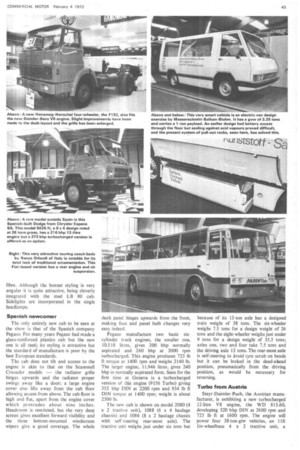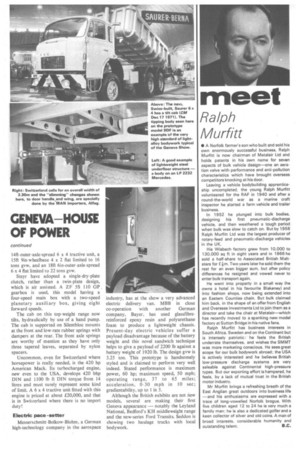GENEVA--HOUSE OF POWER
Page 42

Page 43

Page 44

Page 45

Page 46

If you've noticed an error in this article please click here to report it so we can fix it.
by Gibb Grace, CEng, DAuE, MIMechE
DAF, Mercedes, Pegaso and Steyr have new engines on show for the first time and Scania, Hanomag-Henschel, Pegaso and Mercedes have new models on display at the Geneva International Motor Exhibition.
Four British companies Bedford, British Leyland, Ford and Seddon are well represented at the show, which closes tomorrow, but none is exhibiting any new models. • ' The new West German legislation requiring 8 bhp /ton on heavy trucks has forced engine powers up to 304 bhp for the typical 38-ton-gtw vehicle but already this output seems to have become a minimum rather than a typical output for the big engine. Possibly because there was no Frankfurt Show last year many manufacturers have taken the opportunity of Geneva to exhibit a bigger number of heavy vehicles than normal. Almost every Continental manufacturer has a 300 hp engine on show and many have engines in the 350 hp class. Big engines mean big drive lines and again there is a remarkable variety of types to be seen.
The show, the second at Geneva to be devoted solely to commercials, is truly international with exhibits from 140 chassis manufacturers and bodybuilders from 22 countries including Canada, Japan and the USA on display in the six acres of covered exhibition and outside in a large demonstration park.
A new turbocharged DAF engine announced at the show, type DKB 1160, available in all F 2600 series vehicles,
produces 304 bhp DIN at 2200 rpm and 780 lb ft. DIN torque at 1500 rpm. The West German power to weight requirement (8 bhp/ton) is already required to be met by foreign operators before special licences are granted, as for example when applying to drive on Sundays. The possible spread in the future of the 8 bhp/ton to all visiting vehicles and the need to maintain good average speeds in ever denser traffic has convinced DAF of the need for this high power engine. The DAF drive line has been adapted to cope with the extra power; clutch springs have been strengthened and a ZF nine-speed constant-mesh gearbox adopted. This box model 5K 110 GP, is basically a four-speed design with range-change and a crawler gear.
The cab on the DKB 1160-powered DAF is mounted two inches higher and the engine cover has been altered to accommodate the engine. Externally the headlamp panel is now black and carries a bold "304" insignia.
Daimler-Benz have their much-heralded V8 diesel on show for the first time. The engine, OM 402, is a derivative of the VIO and has many common features: it is a direct-injection four-stroke design with wet cylinder liners. Output is given as 256 bhp DIN at 2500 rpm and 600 lb ft DIN torque at 1600 rpm.
This output is mild for the engine's 12.76 litres capacity but good for its weight of just over 1700 lb. A spokesman for Daimler-Benz said that there were no firm plans at the moment to export the new engine to the UK but of course it would be possible should future legislation require it (256 bhp gives a 32-ton-gvw vehicle 8 bhp /ton). A new model, the Mercedes-Benz 1926 rigid, is on show fitted with the new engine. This model has the tilt cab, frame, front axle, steering suspension and brakes in common with the type 1932 (V-10-engined model) but the clutch, gearbox and driving axle differ. The single-plate dry clutch is servo assisted and the fully synchromesh ZF 6-90 gearbox is fitted; this is available with a GV 90 splitter gear option, giving 12 forward speeds.
The Mercedes-Benz 13-ton rear axle is new and seen for the first time. Primary • •c by a spiral-bevel crown wheel and secondary reduction by a planetary gearing in the wheel hubs. Daimler-Benz claims that the design gives a weight reduction and improved ground clearance due to the smaller size of the axle casing banjo.
Hanomag-Henschel, an associate company of Daimler-Benz, also has a new 19-ton-gvw rigid on display fitted with the new V8 engine. The cab grille is slightly modified from previous models and the dash layout is improved.
Top of the Swiss pops Scania is the best selling heavy truck (over 14 tons gvw) in Switzerland, 494 vehicles having been sold in 1971, representing 20 per cent of the market. The latest Scania model, a bonneted '140, should help them to keep that lead.
The 140 is available with two V8 engines, the DIA giving 275 bhp DIN and 723 lb ft DIN torque and DS14 (turbocharged) giving 350 bhp DIN and 920 lb ft DIN torque, and in two chassis configurations, 4 x 2 and 6 x 4. These models, intended for forestry, site work or arduous haulage conditions arc no lightweights — the two-axle L 140 weighs 19.5 tons and the three-axle LS 140 23 tons. Both models are available in 12ft 9.5in and 16ft 5.5in wheelbases and LS 140 additionally at 14ft Oin.
The new cab is based largely on the existing LB 80 cab but has a forwardhinging bonnet made in reinforced glass fibre. Although the bonnet styling is very angular it is quite attractive, being cleverly integrated with the steel LB 80 cab. Sidelights are incorporated in the single headlamps.
Spanish newcomer •
The only entirely new cab to be seen at the show is that of the Spanish company Pegaso. For many years Pegaso had made a glass-reinforced plastics cab but the new one is all steel; its styling is attractive but the standard of manufacture is poor by the best European standards.
The cab does not tilt and access to the engine is akin to that on the Seammell Crusader models — the radiator grille hinges upwards and the radiator proper swings away like a door; a large engine cover also lifts away from the cab floor allowing access from above. The cab floor is high and flat, apart from the engine cover which protrudes about nine inches. Headroom is restricted, but the very deep screen gives excellent forward visibility and the three bottom-mounted windscreen wipers give a good coverage. The whole dash panel hinges upwards from the front, making fuse and panel bulb changes very easy indeed.
Pegaso manufacture two basic sixcylinder truck engines, the smaller one, 10.518 litres, gives 200 bhp normally aspirated and 260 bhp at 2000 rpm turbocharged. This engine produces 723 lb ft torque at 1400 rpm and weighs 2140 lb. The larger engine, 11.946 litres, gives 240 bhp in normally aspirated form. Seen for the first time at Geneva is a turbocharged version of this engine (9156 Turbo) giving 352 bhp DIN at 2200 rpm and 934 lb ft DIN torque at 1400 rpm; weight is about 2300 lb.
The new cab is shown on model 2080 (4 x 2 tractive unit), 1088 (6 x 4 haulage chassis) and 1086 (8 x 2 haulage chassis with self-steering rear-most axle). The tractive unit weighs just under six tons but because of its 13-ton axle has a designed train weight of 38 tons. The six-wheeler weighs 7.5 tons for a design weight of 26 tons and the eight-wheeler weighs just under 9 tons for a design weight of 35.5 tons; axles one, two and four take 7.5 tons and the driving axle 13 tons. The rear-most axle is self-steering to avoid tyre scrub on bends but it can be locked in the dead-ahead position, pneumatically from the driving position, as would be necessary for reversing.
Turbo from Austria
Steyr-Daimler-Puch, the Austrian manufacturer, is exhibiting a new turbocharged 12-litre V8 engine, the WD 815.60, developing 320 bhp DIN at 2600 rpm and 723 lb ft at 1600 rpm. The engine will power four 38-ton-gtw vehicles, an lift lin-wheelbase 4 x 2 tractive unit, a 14ft-outer-axle-spread 6 x 4 tractive unit, a 15ft 9in-wheelbase 4 x 2 flat limited to 16 tons gvw, and an 18ft 6in-outer-axle-spread 6 x 4 flat limited to 22 tons gvw.
Steyr have adopted a single-dry-plate clutch, rather than a twin-plate design, which is air assisted. A ZF 5S 110 GP. gearbox is used, this model having a four-speed main box with a two-speed planetary auxiliary box, giving eight forward speeds.
The cab on this top-weight range now tilts, hydraulically by use of a hand pump. The cab is supported on Silentbloc mounts at the front and low-rate rubber springs with dampers at the rear. The front axle springs are worthy of mention as they have only three tapered leaves, separated by nylon spacers.
Uncommon, even for Switzerland where horsepower is really needed, is the 420 hp American Mack. Its turbocharged engine, new even to the USA, develops 420 bhp DIN and 1100 lb ft DIN torque from 14 litres and must surely represent some kind of limit. A 6 x 4 tractive unit fitted with this engine is priced at about £20,000, and that is in Switzerland where there is no import
duty!
Electric pace-setter Messerschmitt-Bolkow-Blohm, a German high-technology company in the aerospace industry, has at the show a very advanced electric delivery van. MBB in close co-operation with another German company, Bayer, has used glassfibrereinforced epoxy resin and polyurethane foam to produce a lightweight chassis. Present-day electric vehicles suffer a payload disadvantage because of the battery weight and this novel sandwich technique helps to give a payload of 2200 lb against a battery weight of 1920 lb. The design gvw is 3.25 ton. This prototype is handsomely styled and is claimed to perform very well indeed. Stated performance is maximum power, 60 hp; maximum speed, 50 mph; operating range, 37 to 65 miles; acceleration, 0-30 mph in 10 sec; gradientability, up to 1 in 5.
Although the British exhibits are not new models, several are making their first Geneva appearance — notably the Leyland National, Bedford's KH middleweight range and the new-series Ford Transits. Seddon is showing two haulage trucks with local bodywork.














































































































































